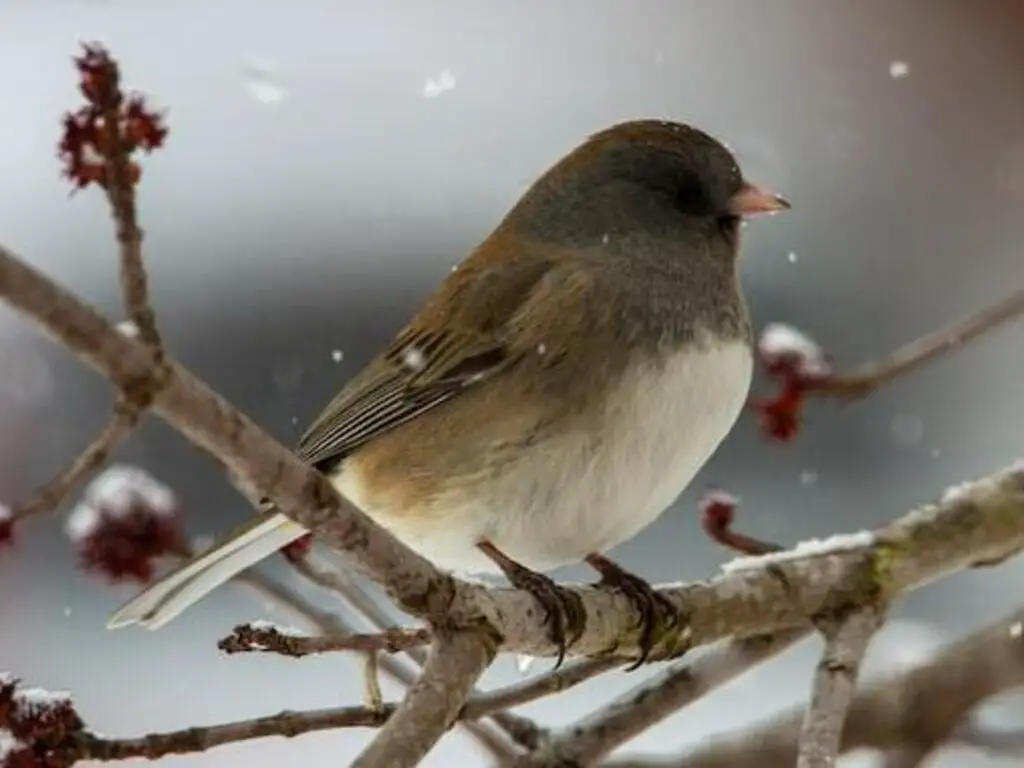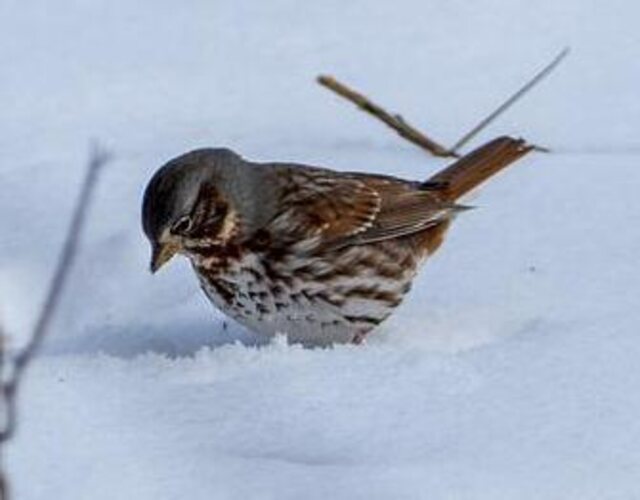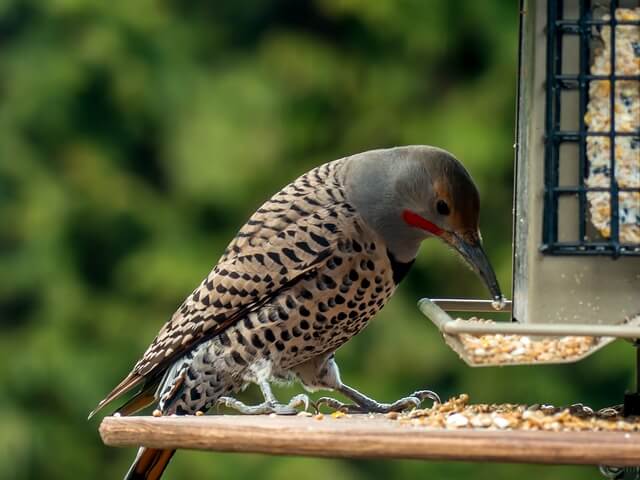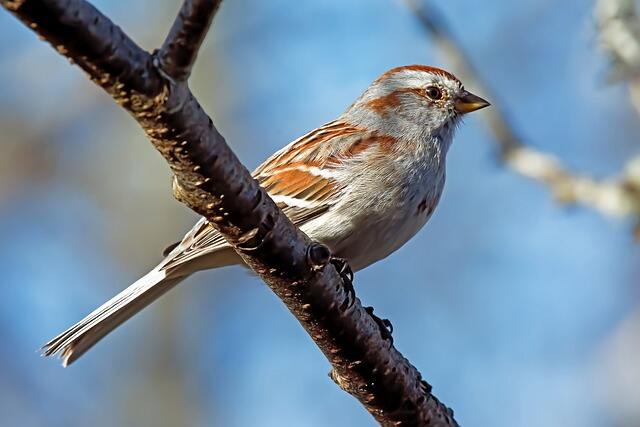Step into Missouri’s winter wonderland and explore the vibrant world of backyard birds with our expert guide featuring 24 species! From the iconic Northern Cardinal to the elusive Tufted Titmouse, Missouri’s landscapes come alive with avian activity during the colder months.
In this comprehensive guide, we’ll uncover the unique characteristics, habitats, and behaviors of these winter residents, offering valuable insights for birdwatchers and nature enthusiasts.
Table of Contents
- 1 Backyard Winter Birds in Missouri
- 1.1 Northern Cardinal
- 1.2 Dark-eyed Junco
- 1.3 Blue Jay
- 1.4 Downy Woodpecker
- 1.5 Red-bellied Woodpecker
- 1.6 Tufted Titmouse
- 1.7 White-throated Sparrow
- 1.8 American Goldfinch
- 1.9 Mourning Dove
- 1.10 European Starling
- 1.11 American Crow
- 1.12 American Robin
- 1.13 White-breasted Nuthatch
- 1.14 Carolina Wren
- 1.15 House Finch
- 1.16 House Sparrow
- 1.17 Northern Flicker
- 1.18 Black-capped Chickadee
- 1.19 Carolina Chickadee
- 1.20 Eastern Bluebird
- 1.21 Song Sparrow
- 1.22 Red-winged Blackbird
- 1.23 Hairy Woodpecker
- 1.24 American Tree Sparrow
- 2 Author
Backyard Winter Birds in Missouri
Northern Cardinal
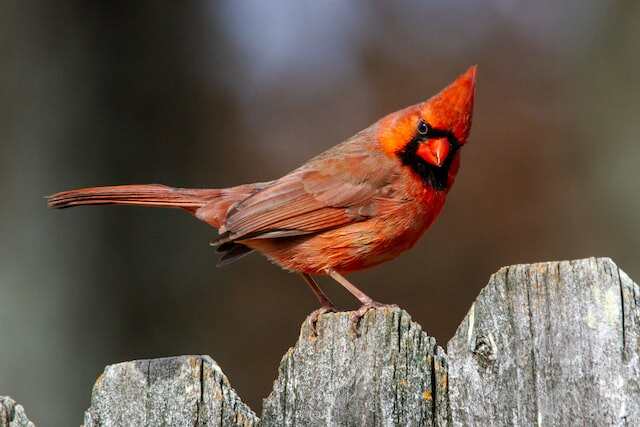
- Length: 8.3-9.1 in (21-23 cm)
- Weight: 1.5-1.7 oz. (42-48 g)
- Wingspan: 9.8-12.2 in (25-31 cm)
- Scientific Name: Cardinalis cardinalis
- Frequency of Occurrence: 62.31% (Statistic: eBird)
- Maps: Range Map – Sightings Map
- Sounds: Calls and Sounds
- Where To Find Them: The Northern Cardinal is a Missouri native. Cardinals can be found in many parts of the state, including St. Louis, Kansas City and Columbia. In winter, cardinals are most likely to be found in wooded areas near rivers and streams. Cardinals are also often seen in backyards and gardens, where they feed on seeds and berries.
- How to Attract Them: The Northern Cardinal are relatively easy to attract, and there are a few key things you can do to make your yard more appealing to them. First, consider adding a platform feeder with black oil sunflower, cracked corn, Nyjer, mealworms, peanuts, safflower. This will give the birds a variety of foods to enjoy and will keep them coming back for more. Another thing you can do is create a water source for them. This can be as simple as adding a birdbath or even just putting out a shallow dish of water. The birds will appreciate having somewhere to drink and bathe, and it will make your yard even more inviting to them. Finally, remember that providing shelter is also important for attracting cardinals.
General Information: The Northern Cardinal is a popular North American bird. It is easily recognized by its red plumage. The bird is found in woodlands, gardens, and backyards throughout the eastern United States and southern Canada. The Northern Cardinal has a wide range and is the official state bird of seven states. The Northern Cardinal is mainly a seed-eater, but it will also eat insects, berries, and fruits. Cardinals stay in one place all year and do not migrate.
In the winter, they form flocks to forage together. During the breeding season, pairs stay close to their territories. Cardinals build their nests in trees or shrubs, often using thorns to help keep them securely in place. The female cardinal does most of the nest building, while the male brings her material. Both parents feed the young birds until they are able to fend for themselves.
Related:
- 10 Best Bird Feeders for Cardinals (Rated for 2022)
- Best Birdhouse for Cardinals 2022 (Tested And Rated)
- Cardinal Bird Facts Every Birdwatcher Should Know!
Dark-eyed Junco
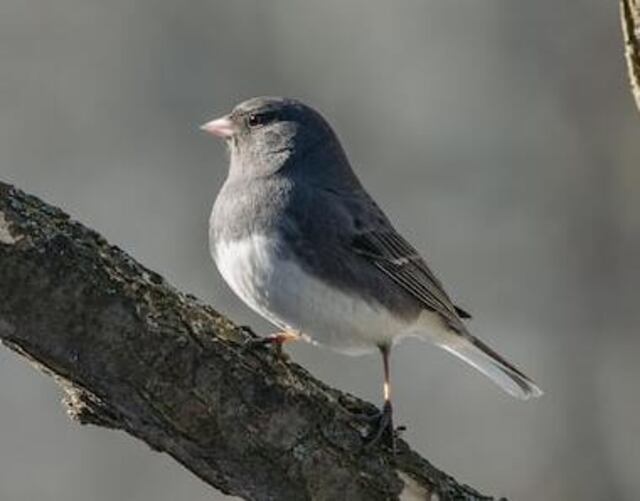
- Length: 5.5-6.3 in (14-16 cm)
- Weight: 0.6-1.1 oz. (18-30 g)
- Wingspan: 7.1-9.8 in (18-25 cm)
- Scientific Name: Junco hyemalis
- Frequency of Occurrence: 56.66%
- Maps: Range Map – Sightings Map
- Sounds: Calls and Sounds
- Where To Find Them: They are commonly found in North America, including Missouri. In winter, they can be found in the southern parts of the state, near the Ozark Mountains.
- How to Attract Them: If you’re hoping to spot a Dark-eyed Junco in your yard, you’ll need to take some steps to attract them. These birds are typically found in wooded areas, so you’ll need to provide some trees or shrubs for them to perch in. You can also put out a platform feeder with hulled sunflower seed, white proso millet, and cracked corn. Keep the feeder clean and fresh, and be patient – it may take a little while for the juncos to find your yard.
General Information: The Dark-eyed Junco (Junco hyemalis) is a small North American songbird. It is the best known and most widespread member of the junco family. The dark-eyed junco has a wide range, breeding across much of Canada and the western and central United States.
It is a permanent resident in the southern parts of its range, including most of Mexico. This bird is found in a variety of habitats, including forests, woodlands, farmlands, and even cities. The dark-eyed junco typically feeds on the ground, eating seeds, insects, and other small invertebrates.
Related:
Blue Jay
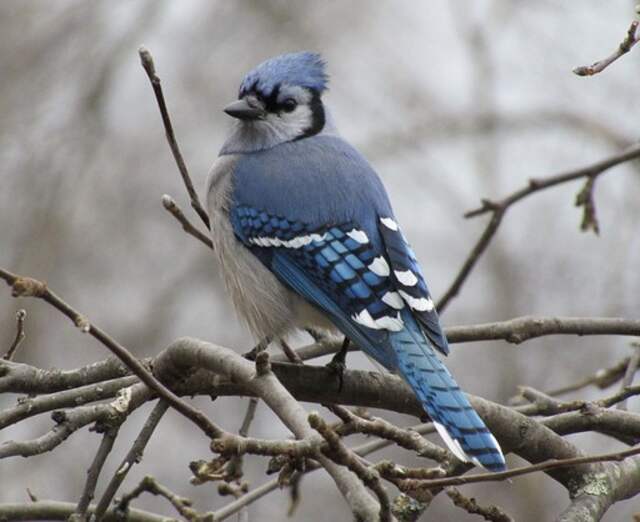
- Length: 9.8-11.8 in (25-30 cm)
- Weight: 2.5-3.5 oz. (70-100 g)
- Wingspan: 13.4-16.9 in (34-43 cm)
- Scientific Name: Cyanocitta cristata
- Frequency of Occurrence: 45.83%
- Maps: Range Map – Sightings Map
- Sounds: Calls and Sounds
- Where To Find Them: During the winter months, Blue Jays can be found in a few different areas of Missouri. Some of these areas include the Ozarks, near rivers and streams, and in wooded areas. While they are not as common in urban areas, they can occasionally be seen in cities as well.
- How to Attract Them: One of the easiest ways to attract blue jays to your yard is by putting out a platform feeder with sunflower seed, cracked corn or mealworms. Blue jays are also attracted to yards with large trees, which provide them with places to perch and nest.
General Information: The Blue Jay is a member of the crow family. It is a perching bird that is native to North America. The Blue Jay has blue feathers with all-white underparts. Its head is blue with a white collar. Its legs are black, and its feet are blue. The Blue Jay’s wings are blue with two white bars. The tail is blue with two white bars. The Blue Jay is about 10 inches long with a wingspan of about 12 inches.
The Blue Jay’s breeding range extends from southern Canada to northern Florida. It is found in most of the eastern United States and parts of the Midwest. The Blue Jay is also found in some western states, including Arizona, Colorado, New Mexico, and Utah. The Blue Jay prefers woods edges, gardens, parks, and suburban areas.
Related:
- What Attracts Blue Jays to your Yard?(Expert Tips)
- 15 Best Bird Feeders For Blue Jays (Tried & Tested 2022)
- What Does A Blue Jay Eat? (10 Favorite Foods Revealed!)
Downy Woodpecker

- Length: 5.5-6.7 in (14-17 cm)
- Weight: 0.7-1.0 oz. (21-28 g)
- Wingspan: 9.8-11.8 in (25-30 cm)
- Scientific Name: Picoides pubescens
- Frequency of Occurrence: 45.15%
- Maps: Range Map – Sightings Map
- Sounds: Calls and Sounds
- Where To Find Them: Downy Woodpeckers can be found in forests, woodlands, and urban areas across Missouri. In winter, they often visit backyard bird feeders in search of food.
- How to Attract Them: They are attracted to yards with trees, but can also be attracted to yards with suet or tube feeders. The best way to attract them is to put out a tube feeder with black oil sunflower seeds, millet, peanuts, or mealworms. You can also use a suet feeder with insect suet.
General Information: The Downy Woodpecker is a small woodpecker found in North and Central America. It is the most widespread woodpecker in the continent, being found in nearly all types of woodland habitat. The Downy Woodpecker feeds primarily on insects but will also eat berries and other small fruits. The Downy Woodpecker has a black and white striped back, with a white belly.
The male has a small red mark on the back of its head, while the female has none. Both sexes have black bars on their wings. The Downy Woodpecker measures between 6 and 7 inches in length, with a wingspan of 10-12 inches. The Downy Woodpecker is found across North America, from Alaska and Canada to Mexico. It is also found in Central America, as far south as Panama.
Related: How to Attract Downy Woodpeckers to Your Yard? (Easy!)
Red-bellied Woodpecker
- Length: 9.4 in (24 cm)
- Weight: 2.0-3.2 oz. (56-91 g)
- Wingspan: 13.0-16.5 in (33-42 cm)
- Scientific Name: Melanerpes carolinus
- Frequency of Occurrence: 43.39%
- Maps: Range Map – Sightings Map
- Sounds: Calls and Sounds
- Where To Find Them: Some of the best places to see red-bellied woodpeckers in Missouri during the winter months include forests, parks, and nature preserves.
- How to Attract Them: If you want to attract a red-bellied woodpecker to your yard, you can do so by putting out a hopper or platform feeder with sunflower seed, peanuts or mealworms. These birds are also attracted to suet, so you could put out a suet feeder as well. Make sure to place the feeders in an open area where the birds can easily see them, and be patient – it may take a little while for the birds to find your new feeders.
General Information: The Red-bellied Woodpecker is a species of woodpecker that is found in North and South America. The bird has a distinctive red belly, which gives it its name. The Red-bellied Woodpecker is a medium-sized bird, with a length of between 9 and 10 inches. The bird has a black back, wings and tail, with white stripes running down its back. The belly of the bird is bright red, as are the sides of the head. They have a dark bill, and their legs are gray.
The Red-bellied Woodpecker is found in forests and woodlands across North America, from Canada to Mexico. In South America, the bird is found in Brazil, Argentina and Uruguay. The bird prefers to nest in trees, but will also use other structures such as buildings and power lines.
Tufted Titmouse
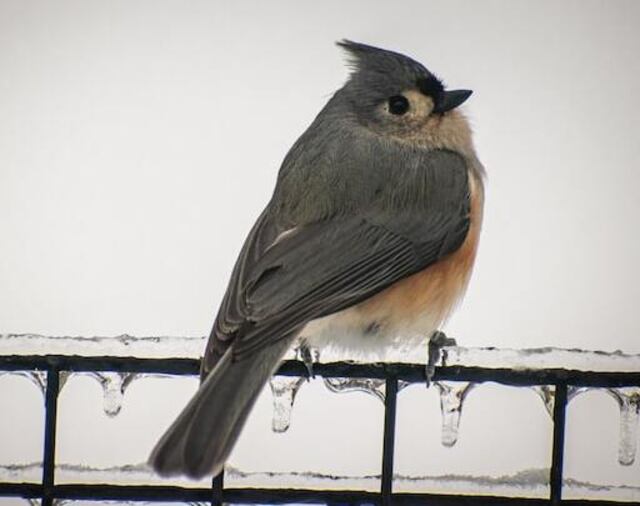
- Length: 5.5-6.3 in (14-16 cm)
- Weight: 0.6-0.9 oz. (18-26 g)
- Wingspan: 7.9-10.2 in (20-26 cm)
- Scientific Name: Baeolophus bicolor
- Frequency of Occurrence: 42.12%
- Maps: Range Map – Sightings Map
- Sounds: Calls and Sounds
- Where To Find Them: The Tufted Titmouse is a small songbird that is found in woodlands throughout the eastern United States. In Missouri, they are most commonly found in the Ozark Mountains and the southeastern part of the state. They are also occasionally seen in the Kansas City area.
- How to Attract Them: To attract Tufted Titmice to your yard, put up a hopper feeder with black oil sunflower seeds, safflower, peanuts, or mealworms. You can also put out suet cakes for them to eat. Keep your feeders clean and filled with fresh food to keep the birds coming back.
General Information: The Tufted Titmouse is a small gray songbird with a white breast and rusty sides. They have a black head with a white eyebrow and are about six inches long. Their habitat ranges from eastern Canada to central Mexico, and they can be found in woodlands, forests, and suburban areas. Sourcing their diet from insects, spiders, berries, and nuts. In the winter they will also eat suet and sunflower seeds.
They will often store food in tree crevices for later use. The Tufted Titmouse is known for their acrobatic abilities as they hang upside down from branches while feeding. They are not shy around humans and will often build their nests in birdhouses or other man-made structures. The female will lay anywhere from four to six eggs, which hatch after about two weeks.
Related: How to Attract Tufted Titmouse to my Yard? (Explained)
White-throated Sparrow
- Length: 6.3-7.1 in (16-18 cm)
- Weight: 0.8-1.1 oz. (22-32 g)
- Wingspan: 7.9-9.1 in (20-23 cm)
- Scientific Name: Zonotrichia albicollis
- Frequency of Occurrence: 35.92%
- Maps: Range Map – Sightings Map
- Sounds: Calls and Sounds
- Where To Find Them: In Missouri, it can be found in winter in the Ozark Plateau, Mark Twain National Forest, and Lincoln Hills.They are typically found in wooded areas but can also be found in open areas such as fields and yards. The ideal time to see them is either early in the morning or later in the evening.
- How to Attract Them: In order to attract a White-throated Sparrow to your yard, you will need to place a platform feeder filled with black oil sunflower seeds, cracked corn, and white proso millet. These sparrows are also attracted to yards with dense shrubbery, so be sure to include some bushes or trees in your landscaping. Once you have established a good food source and shelter for the sparrows, they should start frequenting your yard on a regular basis.
General Information: The White-throated Sparrow (Zonotrichia albicollis) is a small songbird found throughout North America. The sparrow gets its name from the white throat patch which is visible on both males and females. The bird is also known for its distinctive brown and white stripes on its head. The White-throated Sparrow has a large range, stretching from Alaska to Newfoundland in the north and south to California and Mexico.
The bird is most commonly found in open woodlands but can also be found in urban areas such as parks and gardens. The White-throated Sparrow’s diet is focused on grains and insects. In the winter, when food is scarce, the sparrow will eat berries and fruits. To find food, the sparrow uses its long beak to probe into the ground.
American Goldfinch
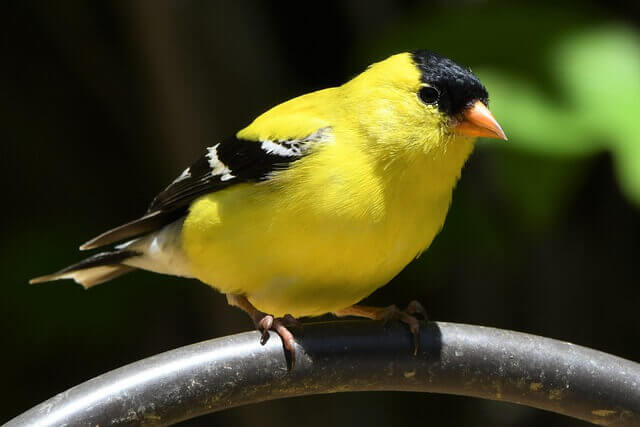
- Length: 4.3-5.1 in (11-13 cm)
- Weight: 0.4-0.7 oz. (11-20 g)
- Wingspan: 7.5-8.7 in (19-22 cm)
- Scientific Name: Spinus tristis
- Frequency of Occurrence: 35.86%
- Maps: Range Map – Sightings Map
- Sounds: Calls and Sounds
- Where To Find Them: In winter, the American goldfinch can be found in many different areas of Missouri. One of the most popular places to find them is in the Ozarks. The Ozarks offer a variety of habitats for the goldfinches, including forests, fields, and meadows. Another great place to find them is along the Mississippi River. The Mississippi River provides a lot of food for the goldfinches and other birds.
- How to Attract Them: The American Goldfinch is a beautiful little bird that can easily be attracted to your yard with the right feeder. A tube or mesh feeder with thistle or sunflower seeds is ideal. The key is to keep the feeder clean and filled so the birds always have access to food.
General Information: The American Goldfinch is a small songbird with a big voice. Measuring just five to six inches in length, this finch is one of the smallest North American birds. The male American Goldfinch has a black cap and wings with yellow bars, while the female is more drab, with grayish-brown plumage. The bird’s diet consists mostly of seeds, but they will also eat insects and other small invertebrates.
The American Goldfinch breeds across most of North America, from southern Canada to northern Mexico. They are permanent residents in the southwestern United States. In winter, they often form flocks with other goldfinches and move south in search of food. The American Goldfinch can be found in open habitats such as fields, meadows, and roadsides.
Related:
- Interesting American Goldfinch Facts You Need to Know!
- 9 Birds That Look Like Goldfinches (Explained)
Mourning Dove

- Length: 9.1-13.4 in (23-34 cm)
- Weight: 3.4-6.0 oz. (96-170 g)
- Wingspan: 17.7 in (45 cm)
- Scientific Name: Zenaida macroura
- Frequency of Occurrence: 34.55%
- Maps: Range Map – Sightings Map
- Sounds: Calls and Sounds
- Where To Find Them: The Mourning Dove is a North American bird that can be found in Missouri during the winter. There are several areas where they have been known to reside, including: * The outskirts of Kansas City, Columbia, and Jefferson City. These birds are typically found in wooded areas near open fields, making Missouri a perfect place for them to spend the winter.
- How to Attract: The best time to see mourning doves in your yard is early morning or late evening. The birds feed on the ground and prefer open areas such as fields or lawns. You can attract them to your yard by putting out a platform feeder with milo, millet, safflower, and cracked corn.
General Information: The Mourning Dove is a medium-sized, slender bird with a long tail. The body is grayish brown with black spots on the wings. The head is grayish with a black band around the eyes. The bill is black and the legs are pink. The Mourning Dove breeds across much of North America, from Alaska and Canada to Mexico. They can also be seen in some areas of Central America. The Mourning Dove is a permanent resident in many areas, but northern birds may migrate south for the winter.
The Mourning Dove prefers open landscapes such as pastures, fields, and farmlands. It also occurs in towns and cities. The diet of the Mourning Dove consists mainly of seeds from grasses and other plants. The Mourning Dove drinks water daily and bathes frequently to keep its feathers clean.
Related:
- Facts About Mourning Doves – 10 Things You Need To Know!
- Best Bird Feeder For Doves (Reviewed & Tested for 2022)
European Starling
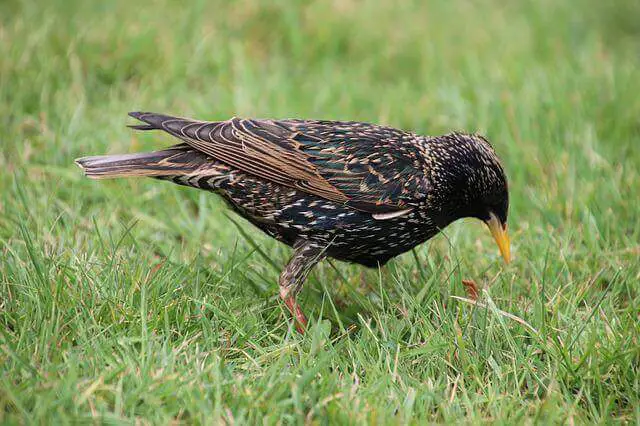
- Length: 7.9-9.1 in (20-23 cm)
- Weight: 2.1-3.4 oz. (60-96 g)
- Wingspan: 12.2-15.8 in (31-40 cm)
- Scientific Name: Sturnus vulgaris
- Frequency of Occurrence: 34.53%
- Maps: Range Map – Sightings Map
- Sounds: Calls and Sounds
- Where To Find Them: There are many areas in Missouri where European Starlings can be found in winter. One of the most popular spots is the Columbia Bottom Conservation Area near St. Louis. This area is home to numerous starlings, and they can often be seen roosting in the trees or flying around in search of food. Another great spot to see these birds is at the Riverlands Migratory Bird Sanctuary in West Alton. This sanctuary is located along the Mississippi River and is a stopping point for many migrating birds.
- How to Attract Them: The European starling is a beautiful bird that can easily be attracted to your yard with the right type of feeder. A platform feeder or tube feeder with Nyjer, black-oil sunflower seeds and sunflower hearts is the perfect way to attract these birds. The key to attracting European starlings is to offer them a variety of foods that they are known to enjoy.
General Information: The European starling (Sturnus vulgaris) is a member of the genus Sturnus in the family Sturnidae. The species originated in Eurasia but has now spread to other continents, including North and South America, Africa and Australasia. The European starling is a small to medium-sized passerine bird with black feathers and yellow eyes. The bird is approximately 20 cm in length and weighs around 50 g. The wingspan is 30-40 cm.
The European starling has a large range, spanning from Europe to Asia and Africa. In Europe, the bird is found in most countries except for Iceland, Ireland, Norway and Sweden. In Asia, the range extends from Turkey to Mongolia and China. The African range includes Algeria, Chad, Ethiopia and Somalia.
Related: How To Attract European Starlings To Your Yard Fast?
American Crow
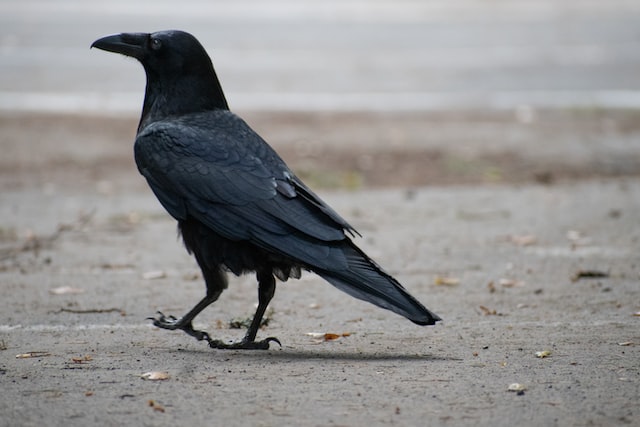
- Length: 15.8-20.9 in (40-53 cm)
- Weight: 11.2-21.9 oz. (316-620 g)
- Wingspan: 33.5-39.4 in (85-100 cm)
- Scientific Name: Corvus brachyrhynchos
- Frequency of Occurrence: 34.07%
- Maps: Range Map – Sightings Map
- Sounds: Calls and Sounds
- Where To Find Them: During the winter months, American Crows can be found in Missouri in a few different areas. One spot is near the Mississippi River, where they congregate in large numbers to roost and forage for food. Another common area is in forest Park in St. Louis, where there are many trees for them to perch in and plenty of food sources. Lastly, they can also be found in rural areas and farmland across the state, where they search for food and shelter in fields and woods.
- How to Attract Them: If you want to attract American crows to your yard, one of the best things you can do is put out a platform feeder filled with corn, peanuts or sunflower seeds. Crows are intelligent birds, and they quickly learn where they can find a reliable food source. Once they know your yard is a good place to eat, they’ll keep coming back.
General Information: The American Crow is a bird of the corvid family. The scientific name means “blackbird” and refers to its black plumage. The adult bird has a wingspan of about 4 feet (1.2 m) and a body length of 16-21 inches (41-53 cm). It is one of the heaviest passerine birds. The American Crow is found throughout North America, from Alaska and Canada to northern Mexico.
It is a very adaptable bird and can live in almost any habitat that has trees, including urban areas, forests, and farmlands. The diet of the American Crow consists mostly of invertebrates, but it will also eat fruits, seeds, eggs, nestlings, small mammals, and carrion. In winter, the diet shifts to include more fruits and nuts as invertebrates become scarce.
Related:
- How To Attract Crows To Your Backyard: Expert Tips!
- 16 Birds That Look Like Crows But Aren’t (Complete Guide)
American Robin
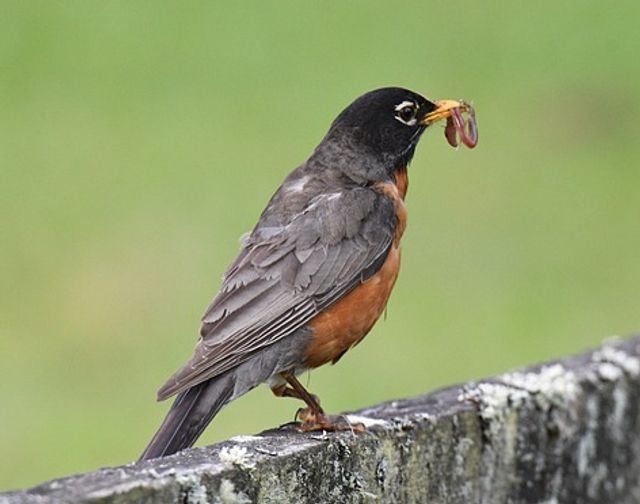
- Length: 7.9-11.0 in (20-28 cm)
- Weight: 2.7-3.0 oz (77-85 g)
- Wingspan: 12.2-15.8 in (31-40 cm)
- Scientific Name: Turdus migratorius
- Frequency of Occurrence: 31.70%
- Maps: Range Map – Sightings Map
- Sounds: Calls and Sounds
- Where To Find Them: The American Robin is a migratory bird that can be found in Missouri during the winter months. Some of the best places to see them are at the Columbia Audubon Society Sanctuary, Eagle Bluffs Conservation Area, and the Riverlands Migratory Bird Sanctuary.
- How to Attract Them: If you want to attract American robins to your yard, put up a platform feeder and offer mealworms. You can also try hanging a grape jelly feeder; many birds enjoy eating grape jelly, but robins seem to especially like it. Be sure to clean your feeders regularly and keep them filled with fresh food; otherwise, the birds will go elsewhere.
General Information:The American Robin (Turdus migratorius) is a migratory songbird native to the western hemisphere of the thrush genus and Turdidae, the wider thrush family. The American Robin is widely distributed throughout North America, wintering in southern Canada and northern Mexico. It is the official state bird of Connecticut, Michigan, and Wisconsin. According to some sources, the American Robin ranks seventh on a list of the most common birds in North America.
The adult robin is about 20 cm (8 inches) long and has dark gray-brown upperparts with a paler belly and throat. Its head has a striking rusty-red breast, white eye-ring, black head with a small white crescent above its bill. The legs and feet are blackish brown.
Related:
- How To Attract Robins To Your Yard – 7 Best Tips!
- 5 Best Bird Feeders For Robins (Tested & Rated For 2022)
- 9 Birds That Look Like Robins But Aren’t (Photos, & Info)
White-breasted Nuthatch
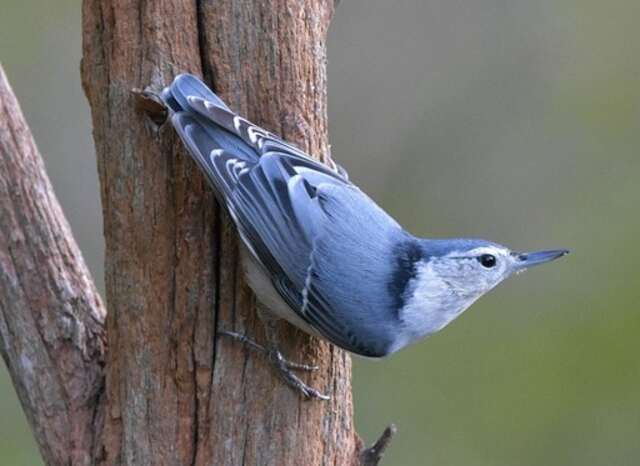
- Length: 5.1-5.5 in (13-14 cm)
- Weight: 0.6-1.1 oz. (18-30 g)
- Wingspan: 7.9-10.6 in (20-27 cm)
- Scientific Name: Sitta carolinensis
- Frequency of Occurrence: 30.18%
- Maps: Range Map – Sightings Map
- Sounds: Calls and Sounds
- Where To Find Them: The White-breasted Nuthatch is most commonly found in the Ozark Mountains and the Mark Twain National Forest. It can also be found in urban areas, such as St. Louis and Kansas City.
- How to Attract Them: To attract nuthatches, place a hopper or platform feeder filled with nuts, sunflower seeds, mealworms, suet, and peanut butter in an area near some trees. Nuthatches will also appreciate a birdbath for bathing and drinking. Keep your feeders clean and stocked with fresh food, and soon you’ll be enjoying these little visitors all year round!
General Information: The White-breasted Nuthatch is a small, acrobatic bird that is found in North America. These birds are most commonly seen in wooded areas, where they use their strong beaks to pry open nuts and seeds. The White-breasted Nuthatch has a wide range, extending from Alaska and Canada all the way down to Mexico.
These birds are year-round residents in most of their range, but some northern populations may migrate south for the winter. The White-breasted Nuthatch is a common backyard bird, and can often be seen feeding on suet or sunflower seeds. These birds will also eat insects, making them valuable members of the ecosystem.
Related:
- How to Attract Nuthatches to your Backyard? Expert Tips!
- 9 Birds That Can Walk Down A Tree (The Complete Guide!)
Carolina Wren
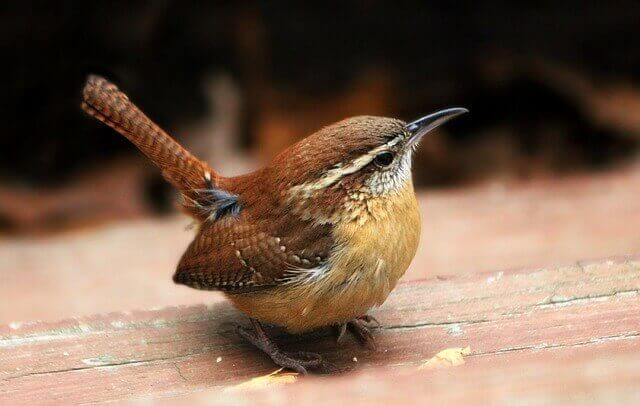
- Length: 4.7-5.5 in (12-14 cm)
- Weight: 0.6-0.8 oz (18-22 g)
- Wingspan: 11.4 in (29 cm)
- Scientific Name: Thryothorus ludovicianus
- Frequency of Occurrence: 29.51%
- Maps: Range Map – Sightings Map
- Sounds: Calls and Sounds
- Where To Find Them: Carolina Wrens are found throughout Missouri, but they are most common in the southeastern part of the state. They can also be found in the Ozark region, but they are less common there. Carolina wrens prefer to live in wooded habitats, but they can also be found in urban areas.
- How to Attract Them: Carolina Wren can be attracted to your yard by providing a platform feeder stocked with sunflower seeds, peanut pieces, and mealworms. In addition to the food, Carolina Wrens also need water for drinking and bathing. A birdbath or shallow dish filled with fresh water will help attract them to your yard. Once they find your yard to their liking, you can expect to hear their loud, cheerful song as they sing from the treetops!
General Information: The Carolina Wren is a small songbird with a short tail that is often cocked upward. The adult has rusty-brown upperparts, white underparts with heavy brown streaks, and a long bill. It is the only member of its genus found in North America. The Carolina Wren’s range extends from southeastern Canada to central Florida, and west to eastern Texas and southeastern Oklahoma.
This bird prefers habitats with dense understory cover and can be found in both deciduous and evergreen forests, as well as gardens, parks, and city neighborhoods. The Carolina Wren forages on the ground or in low vegetation, probing beneath leaves or dead leaves in search of insects. It also eats berries, fruits, and some seeds.
Related: How to Attract Wrens to your Backyard? (Expert’s Guide)
House Finch
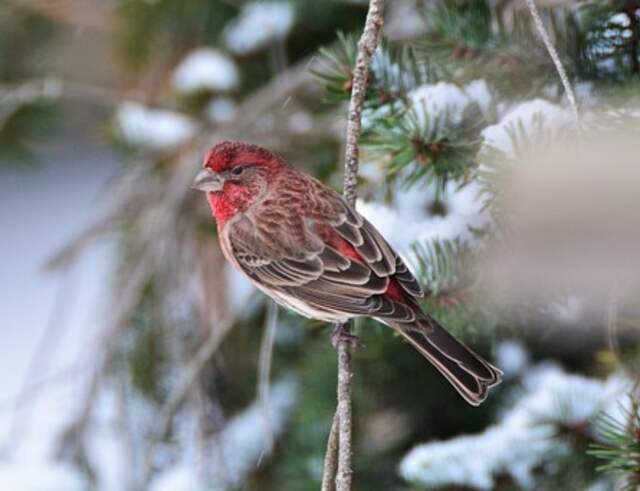
- Length: 5.1-5.5 in (13-14 cm)
- Weight: 0.6-0.9 oz. (16-27 g)
- Wingspan: 7.9-9.8 in (20-25 cm)
- Scientific Name: Haemorhous mexicanus
- Frequency of Occurrence: 28.03%
- Maps: Range Map – Sightings Map
- Sounds: Calls and Sounds
- Where To Find Them: The House Finch is a bird that is found in many different parts of the United States. Missouri is no exception to this rule, as the House Finch can be found in many different parts of the state. Some of the most common places that you can find these birds are in urban areas, such as St. Louis and Kansas City. However, they can also be found in more rural areas, such as Springfield and Columbia.
- How to Attract Them: The house finch is a common bird found in North America. They are attracted to yards with platform, hopper, and tube feeders that contain Nyjer and thistle seed. By providing these food sources, you can attract house finches to your yard.
General Information: The House Finch is a small songbird that ranges across North America. They are commonly found in urban and suburban areas, making them one of the most familiar birds in North America. Their diet consists mainly of seeds and insects. In winter, they often eat berries and fruits. House finches are relatively small birds, measuring only about 5-6 inches in length. They have reddish brown plumage on their upperparts, with grayish brown on their undersides.
Their tail is forked and their bill is short and conical. Males typically have brighter plumage than females. House finches are widespread across North America, from Alaska to Newfoundland south to Mexico. They are generally found in open habitats such as fields, gardens, and parks. In winter, they often congregate in large flocks near sources of food.
Related:
- How to Attract House Finch to your Yard? (Easy & Fast)
- 9 Best Birdhouse for Finches? (Rated & Tested for 2022)
House Sparrow
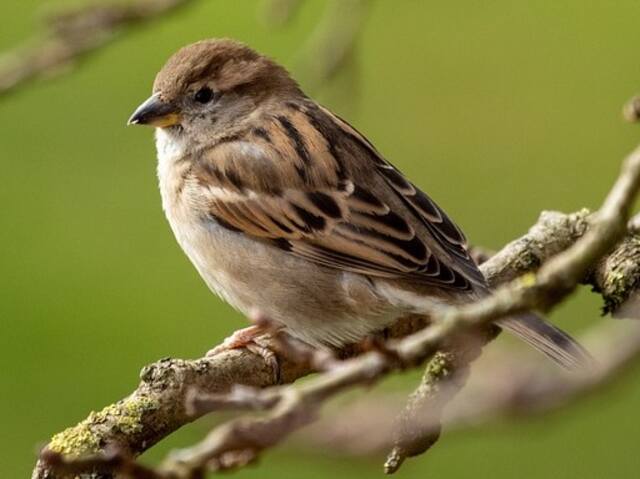
- Length: 5.9-6.7 in (15-17 cm)
- Weight: 0.9-1.1 oz. (27-30 g)
- Wingspan: 7.5-9.8 in (19-25 cm)
- Scientific Name: Passer domesticus
- Frequency of Occurrence: 25.93%
- Maps: Range Map – Sightings Map
- Sounds: Calls and Sounds
- Where To Find Them: The House Sparrow is a small bird that can be found in many different areas across Missouri. They are typically found near human habitation, as they often nest in man-made structures such as houses and barns. House Sparrows are also commonly seen in parks and other open spaces near people.
- How to Attract Them: If you want to attract house sparrows to your yard, there are a few things you can do. First, get a hopper feeder and fill it with Nyjer, thistle or cracked corn. Then, make sure to keep the feeder clean and put out fresh food regularly. Finally, keep your yard free of debris and clutter so the sparrows feel comfortable making it their home.
General Information: The House Sparrow is a sparrow of the true sparrow family Passeridae. It is also known as the English Sparrow or simply the House Sparrow in North America. It breeds throughout most of temperate Europe, Asia and parts of North Africa. The range of the House Sparrow has expanded greatly in recent times, aided by deliberate introductions and escapes as well as range expansion due to global warming.
House Sparrows are generally found in open habitats with some trees or bushes, such as farmland, parks and gardens. Diet consists mostly of insects and seeds; other food items include nectar, berries, and various fruits. In wintertime, when insects are scarce, they will visit bird feeders and eat almost any type of seed. Some House Sparrows may even enter houses in search of crumbs.
Related:
- How to Attract Sparrows to your Backyard? (Like A Pro)
- Birds That Look Like Sparrows: 16 Most Common Types!
Northern Flicker
- Length: 11.0-12.0 in (28-31 cm)
- Weight: 3.9-5.6 oz. (110-160 g)
- Wingspan: 16.5-20.0 in (42-51 cm)
- Scientific Name: Colaptes auratus
- Frequency of Occurrence: 24.35%
- Maps: Range Map – Sightings Map
- Sounds: Calls and Sounds
- Where To Find Them: The Northern Flicker is a woodpecker that is found in Missouri. There are some spots or areas where they are found more frequently. One such spot is the Mark Twain National Forest. This forest provides the perfect habitat for the Northern Flicker with its many trees and open areas. Another spot where the Northern Flicker can be found is near bodies of water such as lakes and rivers.
- How To Attract: If you want to attract Northern Flickers to your yard, put up a platform feeder and fill it with black oil sunflower seeds or peanuts. You’re more likely to see these handsome birds in the spring and fall, but they may visit your feeder year-round if you live in their range. Keep your feeder clean and stocked, and enjoy watching these acrobatic eaters!
General Information: The Northern Flicker is a species of bird in the woodpecker family. It is native to North America, where it ranges from Alaska and northern Canada to Mexico. The Northern Flicker is a medium-sized bird, with a length of 11-12 inches and a wingspan of 16-20 inches. The most distinguishing feature of this bird is its red underwing, which is visible when the bird is in flight.
The Northern Flicker inhabits forests, woodlands, and gardens, and can be found year-round in most of its range. Its diet consists primarily of insects, but it will also eat berries and fruits. In winter, the Northern Flicker may form flocks with other birds and forage for food together.
Related: How to Attract Northern Flickers to your Backyard? (Easy)
Black-capped Chickadee

- Length: 4.7-6.0″ in (12.0-15.2 cm)
- Weight: 0.3-0.5 oz. (9-14 g)
- Wingspan: 6.3-8.3 in (16-21 cm)
- Scientific Name: Poecile atricapillus
- Frequency of Occurrence: 23.79%
- Maps: Range Map – Sightings Map
- Sounds: Calls and Sounds
- Where To Find Them: These birds are very adaptable and can be found in a variety of habitats, including forests, woodlands, and even urban areas. One of the best places to see Black-capped Chickadees in Missouri is at the Meramec State Park, where these birds are often seen flitting among the trees. Another great spot to look for them is at the Springfield Conservation Nature Center, where they are often seen feeding on insects in the forested areas.
- How to Attract Them: When it comes to attracting black-capped chickadees to your yard, there are a few key things to keep in mind. First, they love tray, tube or hopper feeders – especially in winter. Second, they’re big fans of suet, peanuts, and peanut butter. And lastly, remember that these little birds are quite shy, so don’t try to approach them too closely or make too much noise. If you follow these simple tips, you’ll soon have a flock of happy chickadees right in your own backyard!
General Information: The Black-capped Chickadee is a small songbird found in North America. Its crown and throat are black with white sides to its face. The rest of its upperparts are greyish-brown and its underparts are whitish. It has a short tail and legs. Black-capped Chickadees are found in woods and forests across Canada and the northern United States.
They breed in areas with trees, including both coniferous and deciduous forests. In winter, they often move to lower elevations and more open habitats, such as gardens, parks, and suburban areas. Black-capped Chickadees eat mainly insects in the summer months. In winter, they switch to a diet of seeds, berries, and nuts.
Related:
- Unique Black-capped Chickadee Facts You Need To Know!
- Best Bird Feeder For Chickadees (The Ultimate Guide 2022)
- How Do I Attract Chickadees To My Yard (Expert Tips)
Carolina Chickadee
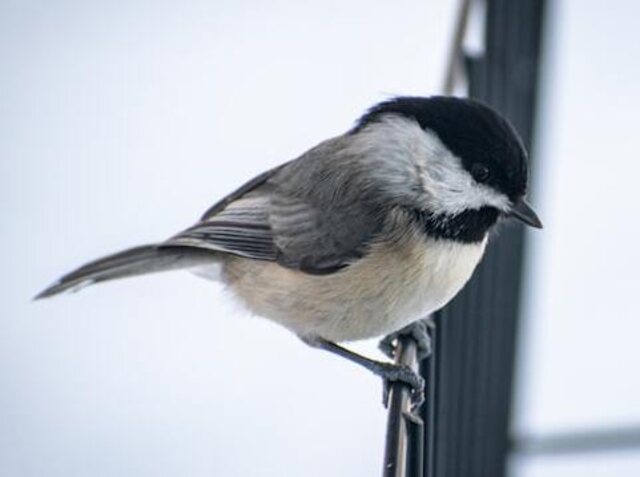
- Length: 4.7-6.0″ in (12.0-15.2 cm)
- Weight: 0.3-0.5 oz (9-14 g)
- Wingspan: 6.3-8.3 in (16-21 cm)
- Scientific Name: Poecile carolinensis
- Frequency of Occurrence: 21.70%
- Maps: Range Map – Sightings Map
- Sounds: Calls and Sounds
- Where To Find Them: Carolina Chickadees are found in a variety of habitats throughout Missouri. They are common in woodlands, forests and urban areas. Carolina Chickadees can also be found in parks and gardens.
- How to Attract Them: One of the best ways to attract Carolina Chickadees is to put out a tray, tube, or hopper feeder. Make sure to fill the feeder with sunflower seeds and peanuts, as these are two of their favorite foods. Carolina Chickadees are especially fond of sunflower seeds in the winter months. Another good way to attract Carolina Chickadees is to provide them with a water source. A birdbath or small pond will do nicely. The key is to make sure that the water is clean and fresh.
General Information: The Carolina Chickadee is a small songbird found in the eastern United States. The bird has a black cap and bib with white sides to its face. Its back is gray, and its underparts are white. The Carolina Chickadee is approximately 5 inches long with a wingspan of 6 to 8 inches. The male and female look similar, but the males tend to be slightly larger than the females.
The Carolina Chickadee’s breeding range extends from southeastern Canada to northern Florida. The bird is a year-round resident in most of its breeding range, although some birds do migrate south for the winter. The Carolina Chickadee prefers wooded habitats, particularly deciduous forests. It will also use suburban areas as long as there are trees present.
Related: Carolina Chickadees – 9 Best Ways To Attract Them Fast!
Eastern Bluebird
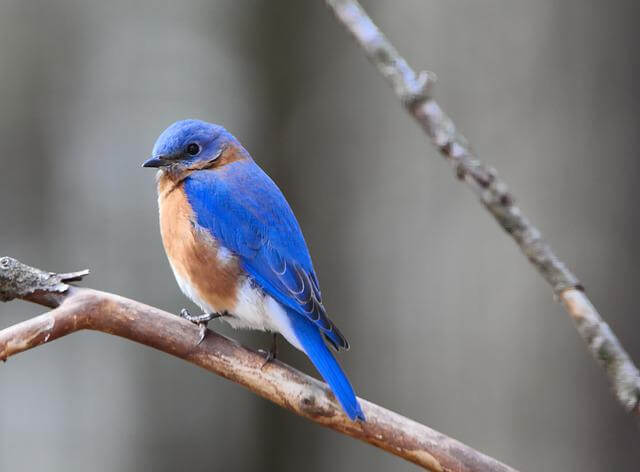
- Length: 6.3-8.3 in (16-21 cm)
- Weight: 1.0-1.1 oz. (28-32 g)
- Wingspan: 9.7-12.5″in. (25-32 cm)
- Scientific Name: Sialia sialis
- Frequency of Occurrence: 20.11%
- Maps: Range Map – Sightings Map
- Sounds: Calls and Sounds
- Where To Find Them: The Eastern Bluebird is found in Missouri in some spots and areas. The most common place to find them is in the eastern part of the state, but they can also be found in central and western Missouri. They are usually found in woods, fields, and gardens.
- How to Attract Them: If you’re hoping to attract an Eastern Bluebird to your yard, one of the best things you can do is put out a platform or hopper feeder with mealworms. Mealworms are a favorite food of these beautiful birds, and having a feeder stocked with them is sure to bring in some feathered visitors.
General Information: The Eastern Bluebird is a small thrush found in open woodlands, farmlands, and gardens in eastern North America. The bluebird is a very popular bird due to its beautiful blue plumage. The male has a blue head, back, and wings with an orange breast, while the female is duller in coloration. The eastern bluebird’s range spans from southeastern Canada to central Mexico.
The bird is most common in the eastern United States, but can also be found in parts of western Canada and Mexico. The habitat of the Eastern Bluebird consists of open areas with trees or shrubs for perching and nesting. The bird often nests in cavities created by other animals, such as woodpeckers.
Related:
- 68 Fun Facts About Eastern Bluebirds (You Didn’t Know!)
- How to Attract Eastern Bluebirds to your Yard (Explained)
- 9 Best Birdhouses for Bluebirds (Top Picks for 2022)
Song Sparrow
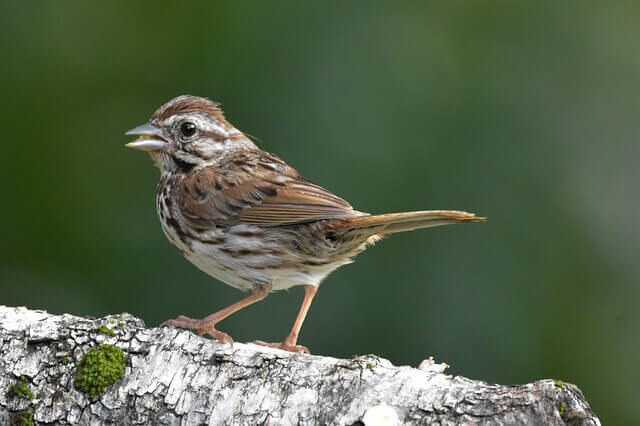
- Length: 4.7-6.7 in (12-17 cm)
- Weight: 0.4-1.9 oz. (12-53 g)
- Wingspan: 7.1-9.4 in (18-24 cm)
- Scientific Name: Melospiza melodia
- Frequency of Occurrence: 17.69%
- Maps: Range Map – Sightings Map
- Sounds: Calls and Sounds
- Where To Find Them: Some of the places where they have been seen are near Columbia, Jefferson City, and Kansas City. These birds typically prefer habitats near water such as marshes or wetlands, but can also be found in open fields or woods. They are usually shy around humans, but can be attracted to backyards with bird feeders.
- How to Attract Them: They are attracted to yards with platfrom or hopper feeders that contain sunflower seed, safflower seed, white proso millet, and thistle seeds. To attract song sparrows to your yard, make sure to keep your feeders clean and filled with fresh seed. You can also add water features such as bird baths or fountains to make your yard more inviting to these little birds.
General Information: The Song Sparrow is a small sparrow with a brown back and gray-brown breast. The head has a streaked crown and pale supercilium. The bill is dark with a pink base. The wings are a brown color with a couple of white stripes. The tail is long and rounded with white outer feathers. Legs and feet are pinkish-brown. Sexes are similar, but females are usually smaller than males. Juveniles are similar to adults but have paler upperparts and streaking on the breast.
This sparrow breeds in North America from Alaska to Newfoundland, south to California, Arizona, and Texas. It is also found in the Great Plains, as well as parts of southern Canada in summer. The Song Sparrow is mostly found in open habitats such as fields, meadows, prairies, pastures, deserts, gardens, parks, and yards.
Red-winged Blackbird
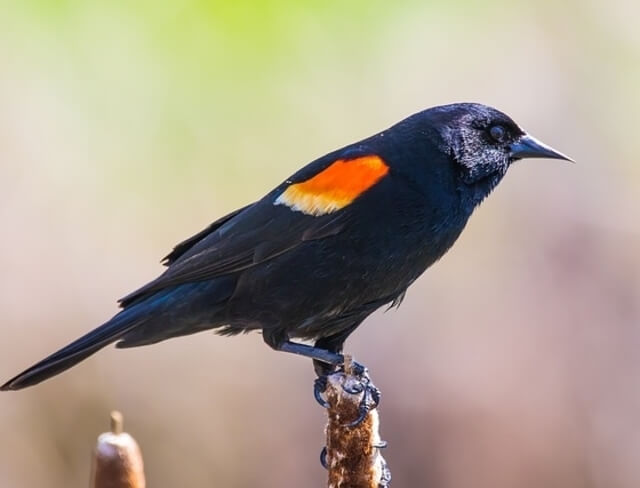
- Length: 6.7-9.1 in (17-23 cm)
- Weight: 1.1-2.7 oz (32-77 g)
- Wingspan: 12.2-15.8 in (31-40 cm)
- Scientific Name: Agelaius phoeniceus
- Frequency of Occurrence: 12.06%
- Maps: Range Map – Sightings Map
- Sounds: Calls and Sounds
- Where To Find Them: There are several areas where these birds can be found in Missouri during the winter months. One such place is Eagle Bluffs Conservation Area near Columbia. This area consists of wetlands and marshes, which provide perfect habitat for the red-winged blackbird. Another place these birds can be found is at Riverlands Migratory Bird Sanctuary near West Alton.
- How to Attract Them: One of the best ways to attract red-wings is by providing them with a good food source. Black oil sunflower seeds, hulled sunflower seeds, and cracked corn are all excellent choices. You can also offer fruit as an additional treat. Place your feeders in an open area away from trees and shrubs so the birds can easily see and access them.
General Information: The Red-winged Blackbird (Agelaius phoeniceus) is a member of the Icteridae family of true blackbirds. The male has distinctive red and yellow wing plumage, while the female is mostly black with some yellow on the wings. They are found across North America, from Alaska and Canada to Mexico and Panama. Red-winged Blackbirds typically inhabit wetlands and marshes, but can also be found in open fields, forest edges, and even suburban areas.
Their diet consists mainly of insects, but they will also eat fruits, seeds, and rice. In winter, their diet shifts to include more fruits and seeds as insects become less available. Red-winged Blackbirds are one of the most widespread birds in North America and are often considered pests due to their loud calls and aggressive behavior towards other birds.
Hairy Woodpecker
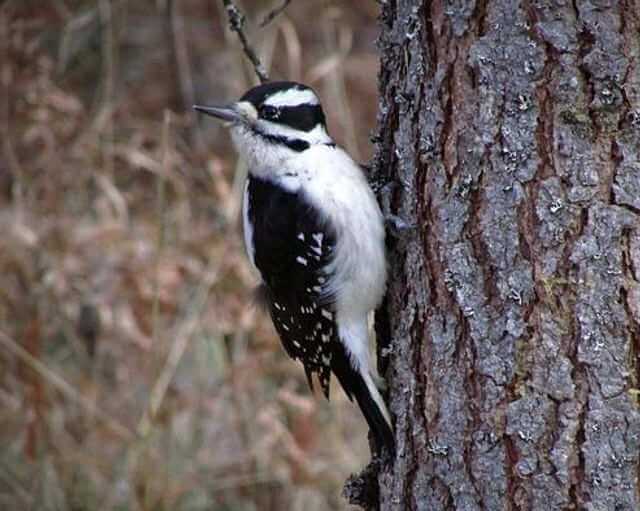
- Length: 7.1-10.2 in (18-26 cm)
- Weight: 1.4-3.4 oz (40-95 g)
- Wingspan: 13.0-16.1 in (33-41 cm)
- Scientific Name: Leuconotopicus villosus
- Frequency of Occurrence: 12.04%
- Maps: Range Map – Sightings Map
- Sounds: Calls and Sounds
- Where To Find Them: Although the Hairy Woodpecker is found throughout Missouri, there are some spots or areas where they seem to be more prevalent in winter. One such area is the Mark Twain National Forest in southeastern Missouri. This forest is home to many different species of trees, including the oak and hickory trees that the Hairy Woodpecker feeds on. Another spot where these woodpeckers can often be seen is along the Mississippi River, where they search for food in the dead trees along the riverbank.
- How to Attract Them: One of the best ways to attract the Hairy Woodpecker is to put out a hopper or platform feeder filled with peanuts and black oil sunflower seeds. These birds are also attracted to suet feeders with peanut butter suet. Another good way to attract them is to leave dead trees or branches in your yard – the Hairy Woodpecker will come to these for food and nesting materials.
General Information: The Hairy Woodpecker is a medium-sized woodpecker found across North America. The bird ranges from Nova Scotia to Alberta in the east, and as far south as Florida and Texas. The Hairy Woodpecker is a common bird of forests and woodlands, where it feeds on insects, larvae, and other small animals.
This bird is most active during the day, although it will also come out at night to feed on occasion. In winter, the Hairy Woodpecker’s diet shifts somewhat, as the bird becomes more reliant on fruits and nuts. The bird will also store food in trees to help tide it over during leaner times.
American Tree Sparrow
- Length: 5.5 in (14 cm)
- Weight: 0.5-1.0 oz. (13-28 g)
- Wingspan: 9.4 in (24 cm)
- Scientific Name: Spizelloides arborea
- Frequency of Occurrence: 11.63%
- Maps: Range Map – Sightings Map
- Sounds: Calls and Sounds
- Where To Find Them: They are found in open woodlands, farmlands, and urban areas in the winter. In Missouri, they are found in the Ozarks and on the Mississippi River.
- How to Attract Them: If you want to attract American Tree Sparrows to your yard, you should put out a hopper feeder with millet, black-oil sunflower seeds, and cracked corn. Be sure to keep an eye on your feeder, though, as these birds can be aggressive when it comes to getting their food.
General Information: In late fall and early winter, the American tree sparrow (Spizella arborea) can be found in woodlands and scrublands across North America. These small sparrows are grayish-brown above and pale below, with a rusty cap and streaked breast. They get their name from the dark brown stripe that extends down their back. American tree sparrows breed in open areas with some trees nearby, such as forests edges, fields, and parks.
In winter, they often form large flocks to forage together in weedy areas. Their diet consists mainly of seeds, but they will also eat insects during the breeding season. You can attract American tree sparrows to your yard by providing a feeding station with seed-bearing plants nearby. These birds are relatively easy to spot due to their distinct plumage and song.
Related: 10 Fascinating American Tree Sparrow Facts
Related Post:

